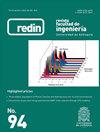利用腐坏希瓦氏菌制备的微生物燃料电池中活性炭电极作为阳极的评价
IF 0.5
Q3 ENGINEERING, MULTIDISCIPLINARY
Revista Facultad De Ingenieria-universidad De Antioquia
Pub Date : 2020-05-13
DOI:10.19053/01211129.v29.n54.2020.10468
引用次数: 1
摘要
研究了三种活性炭在双室微生物燃料电池(MFC)阳极室中作为电极的性能。由于其革兰氏阴性特征,因此使用纯腐坏希瓦氏菌培养物进行评估。在阴极室中,使用铂电极,并选择Nafion®117质子交换膜作为两个室的分离器。不同的前驱体(咖啡壳、商品煤和矿物煤)具有不同的微孔和表面性质。从电压和电流测量中,发现电池功率值在0.008 mW和0.045 mW之间变化。用H3PO4在450°C (Q)下对咖啡壳进行化学活化得到的电极表现出最佳的电化学性能和最高的功率值。这一结果可能主要与碳质材料的宏观形态和介孔提高了其表面润湿性有关。扫描电镜图像显示,生物阳极Q表面形成了更好的生物膜,更大的细菌细丝和微床,这改善了与1博士的相互作用。diana.vanegas@upb.edu.co。2 .波利瓦里亚大学理学硕士(Medellín-Antioquia,哥伦比亚)。monica.cardona@upb.edu.co。ORCID: 0000-0002-5829-3438 3玻利维亚大学博士(Medellín-Antioquia,哥伦比亚)。zulamita.zapata@upb.edu.co。利用腐坏希瓦氏菌(Shewanella Putrefaciens revsta de Ingeniería)作为阳极的活性炭电极在微生物燃料电池中的应用荷兰国际集团(Ing))。第29卷(54),e10468。2020. Tunja-Boyaca,哥伦比亚。L-ISSN: 0121-1129, e-ISSN: 2357-5328, DOI: https://doi.org/10.19053/01211129.v29.n54.2020.10468微生物,其代谢,和电子胞外转移。因此,咖啡壳活性炭可以被认为是一种很有前途的微生物燃料电池电极材料。本文章由计算机程序翻译,如有差异,请以英文原文为准。
Evaluation of Activated Carbon Electrodes as Anodes in a Microbial Fuel Cell Using Shewanella Putrefaciens
In this work, three types of activated carbons were evaluated as electrodes in the anode chamber of a two-chamber microbial fuel cell (MFC). The evaluation was applied using a pure Shewanella Putrefaciens culture due to its gram-negative characteristics. In the cathode chamber, a platinum electrode was used, and a Nafion® 117 proton exchange membrane was selected as a separator of both chambers. The activated carbons were obtained from different precursors (coffee husk, commercial coal, and mineral coal), with different microporous and surface properties. From the voltage and current measurements, it was found that the cell power values varied between 0.008 mW and 0.045 mW. The electrode obtained from chemical activation of coffee husk with H3PO4 at 450 °C (Q) showed the best electrochemical behaviour and highest power values. This result may be mainly related to the macroscopic morphology and mesopores that improve the wettability of the surface by the medium thought carbonaceous material. SEM images showed a better biofilm formation, larger filaments of the bacteria, and micro-beds formation over the surface of bio-anode Q, which improved the interaction with the 1 Ph. D. Universidad Pontificia Bolivariana (Medellín-Antioquia, Colombia). diana.vanegas@upb.edu.co. ORCID: 0000-0002-9519-0841 2 M. Sc. Universidad Pontificia Bolivariana (Medellín-Antioquia, Colombia). monica.cardona@upb.edu.co. ORCID: 0000-0002-5829-3438 3 Ph. D. Universidad Pontificia Bolivariana (Medellín-Antioquia, Colombia). zulamita.zapata@upb.edu.co. ORCID: 0000-0002-4497-4865 Evaluation of Activated Carbon Electrodes as Anodes in a Microbial Fuel Cell Using Shewanella Putrefaciens Revista Facultad de Ingeniería (Rev. Fac. Ing.) Vol. 29 (54), e10468. 2020. Tunja-Boyacá, Colombia. L-ISSN: 0121-1129, e-ISSN: 2357-5328, DOI: https://doi.org/10.19053/01211129.v29.n54.2020.10468 microorganism, its metabolism, and electrons extracellular transfer. Therefore, activated carbon from coffee husk could be considered as a promising material for electrodes of microbial fuel cells.
求助全文
通过发布文献求助,成功后即可免费获取论文全文。
去求助
来源期刊
CiteScore
2.00
自引率
0.00%
发文量
27
审稿时长
2 months
期刊介绍:
Revista Facultad de Ingenieria started in 1984 and is a publication of the School of Engineering at the University of Antioquia.
The main objective of the journal is to promote and stimulate the publishing of national and international scientific research results. The journal publishes original articles, resulting from scientific research, experimental and or simulation studies in engineering sciences, technology, and similar disciplines (Electronics, Telecommunications, Bioengineering, Biotechnology, Electrical, Computer Science, Mechanical, Chemical, Environmental, Materials, Sanitary, Civil and Industrial Engineering).
In exceptional cases, the journal will publish insightful articles related to current important subjects, or revision articles representing a significant contribution to the contextualization of the state of the art in a known relevant topic. Case reports will only be published when those cases are related to studies in which the validity of a methodology is being proven for the first time, or when a significant contribution to the knowledge of an unexplored system can be proven.
All published articles have undergone a peer review process, carried out by experts recognized for their knowledge and contributions to the relevant field.
To adapt the Journal to international standards and to promote the visibility of the published articles; and therefore, to have a greater impact in the global academic community, after November 1st 2013, the journal will accept only manuscripts written in English for reviewing and publication.
Revista Facultad de Ingeniería –redin is entirely financed by University of Antioquia
Since 2015, every article accepted for publication in the journal is assigned a DOI number.

 求助内容:
求助内容: 应助结果提醒方式:
应助结果提醒方式:


